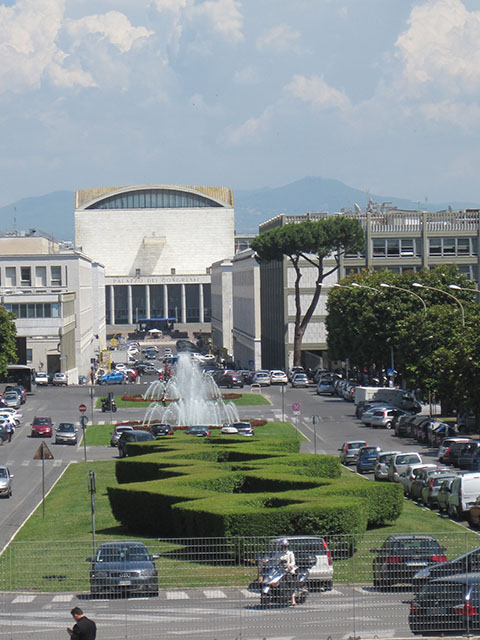 All photos by Ellen Ryan
All photos by Ellen Ryan
Originally named E42, EUR stands for Esposizione Universale Roma, a worlds fair that Benito Mussolini and his administration planned for 1942, to celebrate 20 years of Fascist rule in Italy. The exposition, of course, never happened, due to the intervening of World War II. This district, located on the edge of Rome’s historical center, was intended to showcase the new Italy and its leadership, and was built according to a master plan by architect Marcello Piacentini.
As Diane Ghirardo, author of Italy: Modern Architectures in History (2013), puts it, creating a new identity for Italy during Fascism was about “exquisite images of desired realities.” And the plan for EUR drew heavily on Rome’s extraordinary heritage, borrowing themes and materials from its Imperial past.
And that makes EUR almost uncomfortably enjoyable. It doesn’t quite feel right to enjoy architecture and urban design that both departs from Rome’s classical and Renaissance icons and has its genesis in a totalitarian state. Like many examples of early 20th century design in Italy, one must separate the form from the ideology. However, there is solace in that many of the buildings were completed after WWII, that the site was home to 1960 Olympics events, and the district became a natural place to expand housing, educational and government facilities for the new democracy.
And the buildings hold up beautifully today, with powerful murals and fine materials and sight lines along wide avenues that accentuate the drama and grandeur of its signature structures. It’s no wonder that many Roman professionals and families make their home in the EUR – it’s accessible and full of modern amenities.


And it’s walkable. A quick ride on the Metro B line (Ferma station) deposits you on Viale America. From there it’s a short walk north to the Museo della Civiltà Romana. Far from the beaten path, the museum feels like a cherished school trip destination, with dioramas, diagrams and copies of sculpture. It’s worth a stop for two reasons: the copies of Trajan’s Column bas relief panels which allow you to follow the story of the Roman Emperor’s Dacian Wars victories like a giant graphic novel (the original is located at Trajan’s Forum near Piazza Venezia), and an amazing 1:250 scale model of Imperial Rome, that will remind any New Yorker of the great NYC panorama at the Queens Museum. Just make sure it’s a morning trip – the museum closes at 2pm daily.

From there, walk along Viale della Letteratura to the Palazzo dei Congressi, a modern interpretation of the Pantheon by architect Adalberto Libera. If it’s open, check out the 1953 Gino Severini mural inside. The Palazzo is still used for conferences and exhibitions but will soon be eclipsed by an ambitious new hall designed by Massimilino Fuksas nearby. Nicknamed “the Cloud,” the complex is expected to be completed by 2014. See renderings here.


From there, proceed to the elegant Cafe Palombini on Piazzale Konrad Adenauer 12 for a quick cafe macchiato or lunch. (Adenauer, by the way, was Germany’s first post-war chancellor and widely credited for restoring respect and prosperity to the country.)

After refueling, proceed along Viale della Civiltà Lavoro to EUR’s highlight – the Palazzo della Civiltà Italiana. Known as the Colesseo Quadrato (square coliseum), it is perhaps the most widely-known representation of Fascist architecture, with its particular kind of neo-classic style. The building is often open for exhibitions. At press time, there was a Giorgio Armani show installed.


Proceeding south on Viale Ludwig Van Beethoven, walk to Lago dell’EUR and follow the shoreline path right to reach its southern bank. You’ll find a pavilion housing Golitti, one of Rome’s best and most venerable gelaterias on Viale Oceania 90. This location, unlike the one near the Pantheon, is not mobbed with tourists. Try one of their amazing seasonal flavors and take your cone or cup and watch kayakers on the artificial lake and ponder the complexities of 20th Century architecture in Italy. It’s a great way to end your stroll in the EUR. The metro is just north of the lake to whisk you back to the Centro.

If you have more time, explore EUR’s Palazzo dello Sport designed by Pier Luigi Nervi, the Basilica Santi Pietro e Paolo and glimpse the water tower to the south, known locally as the “mushroom.”


Get in touch with the author @ellenville8.





